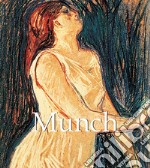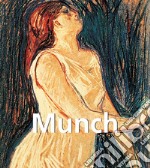Elizabeth Ingles eBooks
eBooks di Elizabeth Ingles di Formato Pdf
Munch. E-book. Formato PDF Elizabeth Ingles - Parkstone International, 2012 -
Edvard Munch, born in 1863, was Norway's most popular artist. His brooding and anguished paintings, based on personal grief and obsessions, were instrumental in the development of Expressionism. During his childhood, the death of his parents, his brother and sister, and the mental illness of another sister, were of great influence on his convulsed and tortuous art. In his works, Munch turned again and again to the memory of illness, death and grief. During his career, Munch changed his idiom many times. At first, influenced by Impressionism and Post-impressionism, he turned to a highly personal style and content, increasingly concerned with images of illness and death. In the 1892s, his style developed a ‘Synthetist' idiom as seen in The Scream (1893) which is regarded as an icon and the portrayal of modern humanity's spiritual and existential anguish. He painted different versions of it. During the 1890s Munch favoured a shallow pictorial space, and used it in his frequently frontal pictures. His work often included the symbolic portrayal of such themes as misery, sickness, and death. and the poses of his figures in many of his portraits were chosen in order to capture their state of mind and psychological condition. It also lends a monumental, static quality to the paintings. In 1892, the Union of Berlin Artists invited Munch to exhibit at its November exhibition. His paintings invoked bitter controversy at the show, and after one week the exhibition closed. In the 1930s and 1940s, the Nazis labeled his work “degenerate art”, and removed his works from German museums. This deeply hurt the anti-fascist Munch, who had come to feel Germany was his second homeland. In 1908 Munch's anxiety became acute and he was hospitalized. He returned to Norway in 1909 and died in Oslo in 1944.
Munch. E-book. Formato PDF Elizabeth Ingles - Parkstone International, 2012 -
Edvard Munch (Løten, 1863 – Ekely, 1944) Munch peut être considéré comme le pionnier de l'expressionnisme dans la peinture moderne. Il a bénéficié tôt de la réputation d'un artiste d'une nouvelle époque marquante en Allemagne et en Europe centrale, et aujourd'hui son oeuvre et son statut sont depuis longtemps reconnus dans toute l'Europe et le monde. Les oeuvres de Munch les plus connues sont celles des années 1890, notamment Le Cri. La fréquentation dans la deuxième moitié des années 1880 de Jæger (auteur norvégien) et de son cercle d'anarchistes radicaux marque un tournant décisif dans la vie de Munch et est la source d'une mutation et d'un conflit interne. A l'automne 1889 Munch a droit à une grande exposition de ses oeuvres à Christiana, où l'État lui accorde une bourse d'artiste pour 3 ans. Paris, où il devient pour un moment l'élève de Léon Bonnat, est une destination logique. Mais l'impulsion la plus importante, il la ressent en s'orientant dans la vie artistique de la ville. C'est à cette époque que perce un mouvement post-impressionniste avec plusieurs expériences anti- aturalistes. Dans ses tableaux dominent les grandes lignes courbes et les zones de couleurs homogènes, une implification et une stylisation utilisée par Paul Gauguin et les synthétistes français. «Symbolisme - la nature a été formée dans une ambiance morale » écrit Munch. A l'automne 1892 Munch présente les fruits de son séjour français. A la suite de cette exposition il est invité par le «club d'art de Berlin » (Berlines Kunstverein), où ces mêmes oeuvres doivent être exposées. Mais cela finit par un cauchemardesque «succès de scandale ». Le public et les vieux peintres comprennent Munch comme une provocation anarchiste, et l'exposition est fermée à cause de la protestation.
Munch. E-book. Formato PDF Elizabeth Ingles - Parkstone International, 2012 -
Der Name „Edvard Munch“ ruft bei den meisten Menschen eine bestimmte visuelle Assoziation hervor: Ein schädelhaftes Gesicht, angstverzerrt, einen stummen, durchdringenden Schrei des Grauens ausstoßend, während im Hintergrund eine feurige, blutrote Sonne untergeht. Der Schrei hat sich im letzten Jahrhundert zu einem ikonischen Sinnbild für die Existenzangst des modernen Menschen entwickelt. Der Schöpfer dieses Kunstwerks war, trotz des immer wiederkehrenden Wahnsinns, der Exzesse, selbstzerstörerischer Beziehungen und einer lebenslang unerfüllten Sehnsucht, ein sanftmütiger und introvertierter Mensch, der immer darauf bedacht war, sich selbst zu reflektieren. Mehr als für viele andere Künstler, war für Munch das Malen ein therapeutischer Prozess, eine Übertragung des Zustands seiner Seele auf Leinwand und Papier. Umso tröstlicher muss es gewesen sein, dass er die internationale Anerkennung seiner Kunst noch miterleben konnte: von der für Furore sorgenden Secessions-Ausstellung in Berlin bis hin zur allgemeinen Wertschätzung des Expressionismus – dessen Künstler er entscheidend mitgeprägt hatte. Dennoch waren auch seine letzten Lebensjahre nicht frei von Kummer: Er musste miterleben wie seine Kunst als „entartet“ gebrandmarkt und seine Heimat von den Streitkräften des dritten Reichs besetzt wurde. Dieses Ebook präsentiert Munchs aufwühlende Lebensgeschichte und eine kompakte Auswahl an Kunstwerken, die mehr sind als nur die Darstellung einer künstlerischen Entwicklung; Sie sind ein Blick in die Seele und den Geist eines genialen und vielfältigen Künstlers.


